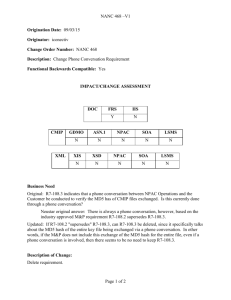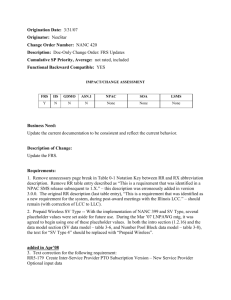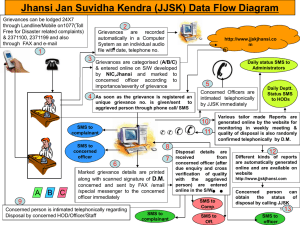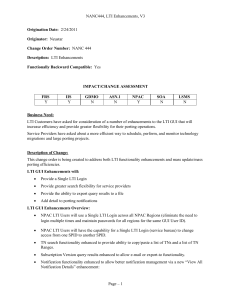Release 3.1 Performance & Volume Test Plan
advertisement
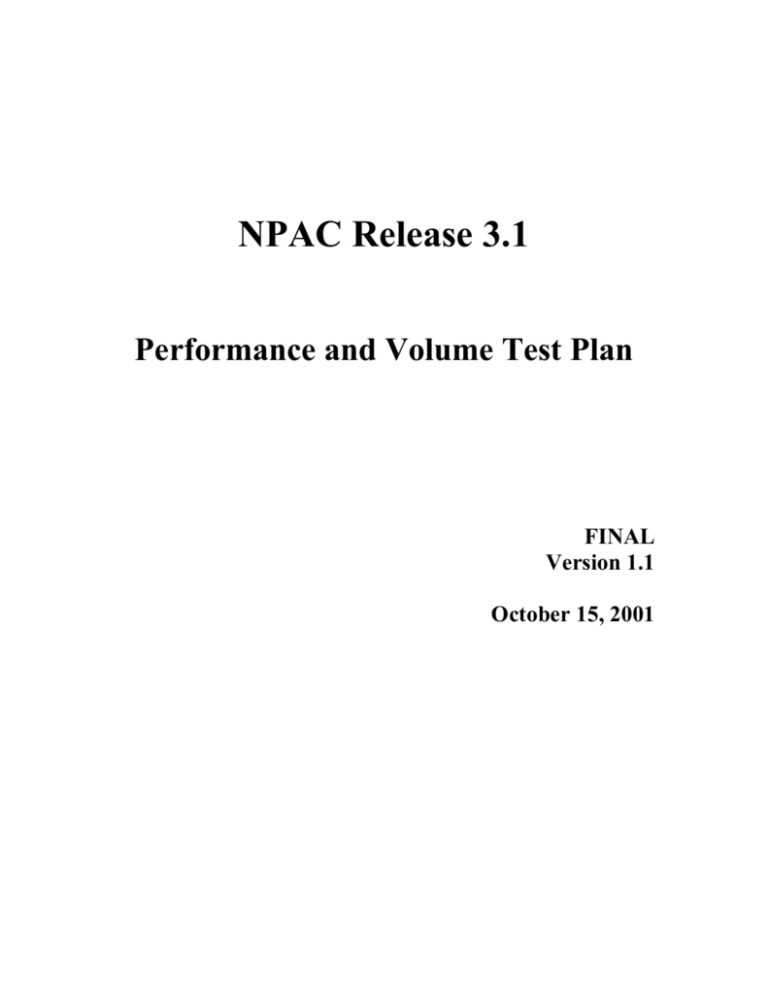
NPAC Release 3.1 Performance and Volume Test Plan FINAL Version 1.1 October 15, 2001 NPAC SMS Release 3.1 Performance and Volume Testing Table of Contents 1. 2. 3. 4. 5. 6. 7. Purpose........................................................................................................................ 3 Test Plan Approach ..................................................................................................... 3 Testing Approach ........................................................................................................ 3 Testing Activities ........................................................................................................ 5 Test Execution ...........................................................Error! Bookmark not defined. Test Results Evaluation............................................................................................... 7 Issues List.................................................................................................................... 8 Final, Version 1.1 2 10/15/2001 NPAC SMS Release 3.1 Performance and Volume Testing 1. Purpose The purpose of this document is to provide a guideline for the performance and volume testing of the NPAC SMS Release 3.1. This performance and volume testing effort is specific for the NPAC SMS Release 3.1 and is different from the performance testing that Service Providers have performed in a group testing environment in the past. This performance and volume testing is designed to specifically test the SOA-NPAC Interface issues that surfaced with the deployment of NPAC SMS Release 3.0 in the Northeast region. The improved performance of NPAC SMS Release 3.0 and the faster hardware platform that this software is running on is resulting in transactions being processed for broadcast to the industry quicker than the SOA-NPAC Interface can transmit them. During peak periods the interface cannot support the volumes of notifications that the NPAC SMS is generating, thus there is a long delay in notification delivery that results in operational issues. At the current time it is the ILEC that is primarily affected by this problem because the ILEC receives the largest volume of SOA notifications but the problem has the potential of affecting any Service Provider. NPAC SMS Release 3.1 is being developed as a short-term solution to the problem described above. The testing described in this test plan will actually focus on the functionality that is contained in Change Order NANC 179, one of the five change orders incorporated into the NPAC SMS Release 3.1. Change Order NANC 179 is perceived as being the key to alleviating throughput problems since the implementation of this change order in both the NPAC SMS and the Service Provider SOAs will result in fewer messages being sent over the interface. 2. Test Plan Approach The SOA Throughput Analysis that was presented to the LNPA WG during its June 2001 meeting was used to help develop the activities that are necessary for this performance and volume testing. The SOA Throughput Analysis was based on notification and request messages that were sent over the SOA-NPAC interface in a 24 hour period, 4/24/01 00:00 UTC – 4/23/01 23:59 UTC. The data collected and analyzed indicated that, for the ILEC, there were two peak periods in the 24-hour period and that each lasted approximately two hours. Activities in the remaining 20 hours of the analysis period was fairly low and for the most part, within the SOA-NPAC interfaces specifications. For this performance and volume testing it was concluded that a volume of activity sufficient to generate in excess of 5000 messages to a particular SOA would be needed to recreate the SOA-NPAC Interface problem. 3. Testing Approach Final, Version 1.1 3 10/15/2001 NPAC SMS Release 3.1 Performance and Volume Testing The performance and volume testing will be performed in a group-testing environment using this test plan. Service Providers will be assigned to work in pairs, one as the Old Service Provider and the other as the New Service Provider. The Service Providers will work together for the complete testing cycle. In the pairing of Service Providers, it is preferable that at least one Service Provider in the pair has a system that supports the new NPAC SMS Release 3.1 features and functionality. Also one of the Service Providers needs to be able to create, modify, and activate subscription versions in ranges. It is suggested that only two pairs of Service Providers perform this testing simultaneously. All phases of this testing will be in the NPAC SMS Release 3.1 test environment. The testing activities will first be executed with the Release 3.1 features and functionality turned OFF in the Service Provider SOAs and in their Service Provider Profile on the NPAC SMS. The purpose of this is to recreate the problem being experienced in the Northeast production environment where NPAC SMS Release 3.0 has been deployed. The testing activities will be executed a second time with the Release 3.1 features and functionality in the Service Provider SOAs and in their Service Provider Profile on the NPAC SMS turned ON. The improvements seen in the second round of testing are the improvements that a Service Provider should expect in the production environment utilizing the Release 3.1 features and functionality. Service Providers will submit large ranges of TNs (1000 at a time) when submitting requests to the NPAC SMS in order to generate large volumes of notifications. If a Service Provider’s SOA system prevents them from submitting range requests to the NPAC SMS it has to be recognized that this Service Provider may not be able to build the notification queue necessary for this testing. To build their queue, they will have to depend on notifications being sent to them as a result of activities involving them being generated by another Service Provider. Also, if they can only enter their data into their SOA system on a single TN basis they may have to spend some time off hours doing setup so as to not impede testing. A certain amount of planning and coordination will need to be done by the NPAC test engineer and all involved Service Providers in order to pair the participating Service Providers and prepare the data required. Once test execution begins all activities need to be completed as efficiently and quickly as possible. To that end, some of the activities that need to be done in advance consist of, but are not limited to: 1. The NPAC test engineer needs to be identified in advance of the testing start date and this person needs to take the lead role in the testing preparations. Some of the tasks that the NPAC test engineer needs to do in advance of the testing start date are: a) analyze the activities to be performed and determine the data and setup that is required for these activities b) ensure that the Service Provider pair assignments are made based on Service Provider system functionality (at least one Service Provider in the pair has a system that supports the new NPAC SMS Release 3.1 features Final, Version 1.1 4 10/15/2001 NPAC SMS Release 3.1 Performance and Volume Testing c) d) e) f) g) h) i) j) and functionality and at least one of the Service Provider in the pair is able to create, modify, and activate subscription versions in ranges assign testing days for each group of 2 pairs of Service Providers ensure accurate set up of Service Provider’s Profile on the NPAC SMS ensure advance set up of the appropriate NPA-NXXs and LRNs by the respective Service Providers ensure SVs exist in the appropriate state for each pair of Service Providers for each run of the testing activities: 5000 “pending” subscription versions to be used for the ‘modify pending’ activities listed in item 3 of the Testing Activities section (both Service Providers have done their creates) 5000 “pending” subscription versions that are ready for activation listed in item 4 of the Testing Activities section. (either both T1 & T2 timers have expired or the Old Service Provider has concurred) Note: This is the prerequisite data setup required for each run of testing activities for items 3 and 4 listed in the Testing Activities section. See the testing activities to determine the total set up required. an LSMS is available for successful activation of subscription versions appropriate filters have been set for the activation of the subscription versions ensure that Service Provider test engineers understand their roles in the testing activities, what testing scenarios will be executed, and in what order ensure that there is adequate NPAC support to monitor queues, logs, etc. 2. Service Provider test engineers need to verify that they have the prerequisite test data in their system before the test run begins. 3. Service Provider test engineers need to understand their role in the activities and be available for the complete testing period. 4. Test Execution After all the testing prerequisites referenced in the Testing Approach section have been completed the Service Provider pairs should commence testing. Ideally there will be three runs of the testing activities, divided into two parts. Part one will be a trial run where each of the 4 activities listed below are executed sequentially. Part two will consist of two runs, one with the 4 activities executed concurrently and a second with the same 4 activities executed concurrently but with the Service Provider roles reversed. All activities should be executed as quickly as possible. These three runs of the testing activities are to be executed using the NPAC Release 3.1 software with the Release 3.1 features and functionality turned OFF in the Service Providers’ SOAs to obtain baseline information and again using the NPAC Release 3.1 software with the Release 3.1 features Final, Version 1.1 5 10/15/2001 NPAC SMS Release 3.1 Performance and Volume Testing and functionality turned ON in the Service Providers’ SOAs to measure the improvements. There will be a total of six runs. The following table lists the testing runs: Both Service Providers participating SP A = New SP SP B = Old SP SP A = Old SP SP B = New SP (Roles reversed) Release 3.1 Features & Functionality OFF ON Trial Run – Testing Trial Run – Testing Activities executed Activities executed sequentially sequentially Run Two Run Two Run Three Run Three During the baseline testing it is expected that overload may become apparent and/or aborts occur. Overload is defined as the Service Provider SOA system waiting excessive amounts of time (more than 30 minutes) to receive a notification that is associated with a previously submitted request from the NPAC SMS. An example would be waiting more than 30 minutes for an M-EVENT REPORT subscriptionVersionStatusAttributeValueChange notification associated with a subscription version create. A SOA system abort could be the result of a CMIP departure time in excess of 5 minutes or not responding to a message within the retry timer tunable parameter (1 X 15 minutes) due to an overload condition. 5. Testing Activities The testing activity needs to be of sufficient volume to ensure that requests will be queued at the NPAC SMS, waiting to be transmitted over the SOA-NPAC Interface when none of the NPAC SMS Release 3.1 features and functionality are being utilized by the Service Provider SOAs. During the performance of all testing activities, NPAC SMS queues will need to be monitored to ensure that the size of the queues expand and contract according to the activity that is taking place. Service Providers need to monitor their systems and note average response times or excessive waits for responses as well as issues/problems with congestion resulting from the volume of messages being transmitted. The following activities are to be performed by each pair of Service Providers. 1. 5000 New Service Provider Creates, submitted as 5 ranges of 1000 TNs each, if possible, otherwise submitted in the most efficient, fastest manner possible. Final, Version 1.1 6 10/15/2001 NPAC SMS Release 3.1 Performance and Volume Testing 2. 5000 Old Service Providers Creates on the same TNs as used in Item 1, submitted as 5 ranges of 1000 TNs each, if possible, otherwise submitted in the most efficient, fastest manner possible. 3. Modification of 5000 existing “pending” subscription versions (the subscription versions created in Item 1 f, first bullet, of the Testing Approach section). Each Service Provider (Old and New) should modify half of the subscription versions (2500 each). They should each submit the modify requests as 2 ranges of 1000 and 1 range of 500, if possible, otherwise submitted in the most efficient, fastest manner possible. 4. Activation of 5000 existing “pending” subscription versions (the subscription versions created in Item 1 f, second bullet, of the Testing Approach section), submitted as 5 ranges of 1000 TNs each, if possible, otherwise submitted in the most efficient, fastest manner possible. 6. Test Results Evaluation Evaluation of the test results will primarily be a measurement of processing time of all testing activities. This processing time will start when the Service Providers commence sending their requests to the NPAC SMS and end when they receive all responses from the NPAC SMS. NPAC has tools that it can use to monitor queues and report times. In addition to the NPAC tools, Service Providers should monitor their systems for response times, errors, congestion, and aborts. It is expected that a Service Provider using a SOA system that has implemented the Release 3.1 features and functionality would see a significant improvement in overall end-to-end processing over the Release 3.1 baseline without the use of the Release 3.1 features and functionality. It is anticipated that at some point during the baseline testing, using NPAC Release 3.1 software with the Release 3.1 features and functionality turned OFF in the Service Providers’ SOAs, overload and/or aborts will occur. The point at which this becomes apparent during the baseline testing should be recorded with details. If a Service Provider’s SOA system experiences overload or aborts during the trial run (the testing activities are being executed sequentially), using NPAC Release 3.1 software with the Release 3.1 features and functionality turned OFF, testing can be terminated for this phase. A Service Provider that is in production, porting small volumes of TNs and not experiencing overload and/or aborts, but has it happen during this phase of the testing should be aware that it is expected behavior. It is expected that during the phase two testing, using NPAC Release 3.1 software with the Release 3.1 features and functionality turned ON in the Service Provider’s SOA, considerable improvement will be seen over the Release 3.1 baseline without the use of the Release 3.1 features and functionality. Final, Version 1.1 7 10/15/2001 NPAC SMS Release 3.1 Performance and Volume Testing 7. Issues List Issue # 1. Date Opened 9/25/01 2. 9/25/01 3. 9/25/01 4. 9/25/01 5. 9/25/01 6. 9/25/01 7. 9/25/01 8. 9/25/01 9. 9/25/01 10. 10/9/01 Final, Version 1.1 Issue Status Should ranges be limited to 100 TNs? How are we going to measure the results? How are we going to get the data over the interface – scripts/SOAs/combination? Will an audit have the same effect on the interface as a query for the same number of SVs? Should a SP that supports Number Pool Block Create & Deletes, other than the ILEC, be the SP doing the Number Pool Block work? How much will creating ‘conflict’ SVs slow down the process, if any? Would it be better to create the SVs and have the NPAC use one of their tools, if they have one, to change the status from ‘pending’ to ‘conflict’? How will the NPAC queues be monitored? What will be monitored? What tools will be used? What type of reports will be generated? What is the time frame that we need to target to get all the data into the system? How are we going to set all this data up and assign to participants? AT&T has some assets that can help May need to add information about possible effects to the testing and evaluation of the 8 9/27/01-Closed. 1000 TN ranges can be submitted. 9/27/01-Closed. Processing time will be the major measurement. 9/27/01-Closed. A combination of SOAs and simulators will be used. 9/27/01-Closed. Non-issue. Testing activities have been redefined. 9/27/01-Closed. Non-issue. Testing activities have been redefined. 9/27/01-Closed. Non-issue. Testing activities have been redefined. 9/27/01-Closed. The NPAC has tools for monitoring queues and reporting times. 9/27/01-Closed. Participants should perform the testing activities as quickly as possible. 9/27/01-Closed. Non-issue. Testing activities have been redefined. 10/12/01-Closed. It was determined that both phases of testing would be done using 10/15/2001 NPAC SMS Release 3.1 Performance and Volume Testing results if the proposed hardware changes go forward. This item will have to be evaluated once the decision is made on the proposed hardware changes Final, Version 1.1 9 the NPAC SMS Release 3.1 software so whether or not the hardware platform changes for Release 3.1 is no longer significant. 10/15/2001

